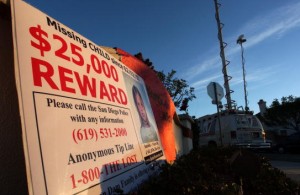
David McNew / Getty Images
A reward poster near television news trucks in San Diego, Calif. advertises the reward for finding Danielle van Dam, 7.
A new TV show premiered this week on TV One, focusing on cases of missing African Americans. One of the first featured stories was about a missing D.C. black woman.
The show, “Finding Our Missing,” aims to correct the disparity in coverage of missing African Americans. For years, critics have blasted media outlets for devoting significant airtime to cases of missing white women, while not devoting similar coverage to cases of missing blacks or Latinos.
Why is there such a disparity, or “coverage gap?” Our sister blog Multi-American pointed to an interview with Poynter Institute faculty member and media ethics expert Kelly McBride. Here is an excerpt:
It’s possible that the people making decisions in newsrooms have a default assumption about what’s normal (functional) and not normal (dysfunctional) for white families. And it’s possible that they have a default assumption about families of color that are the opposite of what they assume for white families. Maybe some of that is true or all of it is true. But it plays into how editors make news judgments.
McBride continued, saying that it’s easier to fix the coverage gap on a local level. She suggested a few strategies:
.. Journalists simply need to make sure they are examining all murders and missing people and giving them similar coverage. (That’s actually really hard to do, but it’s easier than the national solution.) And because local journalists are loyal to their local community, they are generally motivated to serve that audience well.
On a national level, journalists are not accountable in the same way. So there’s less motivation to change the dynamics that lead to tilted coverage. It would take a significant act of leadership at a place like CNN or Fox to break out of this cycle. And I’m not sure there’s enough accountability to make that happen.
You can read the entire Q&A here.











